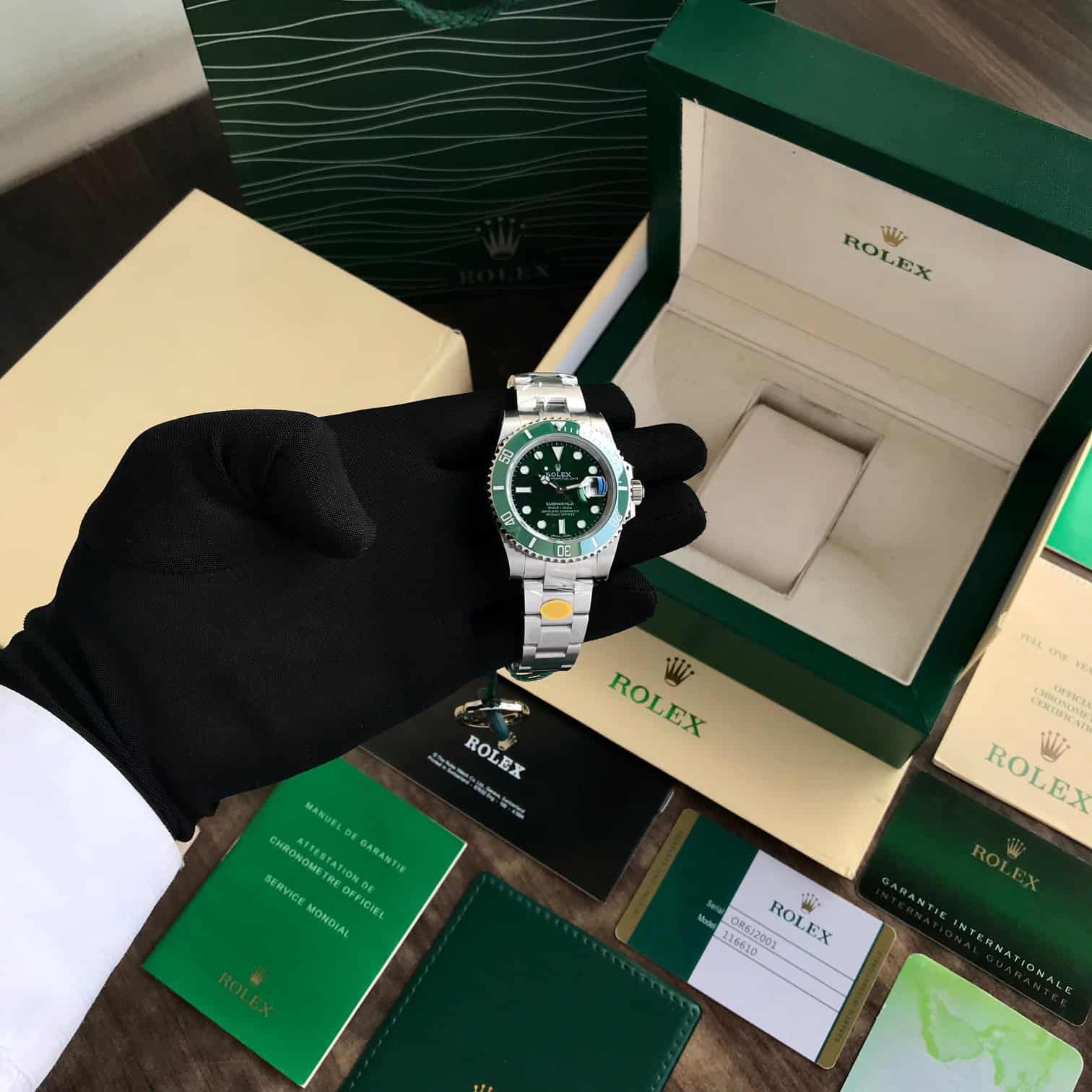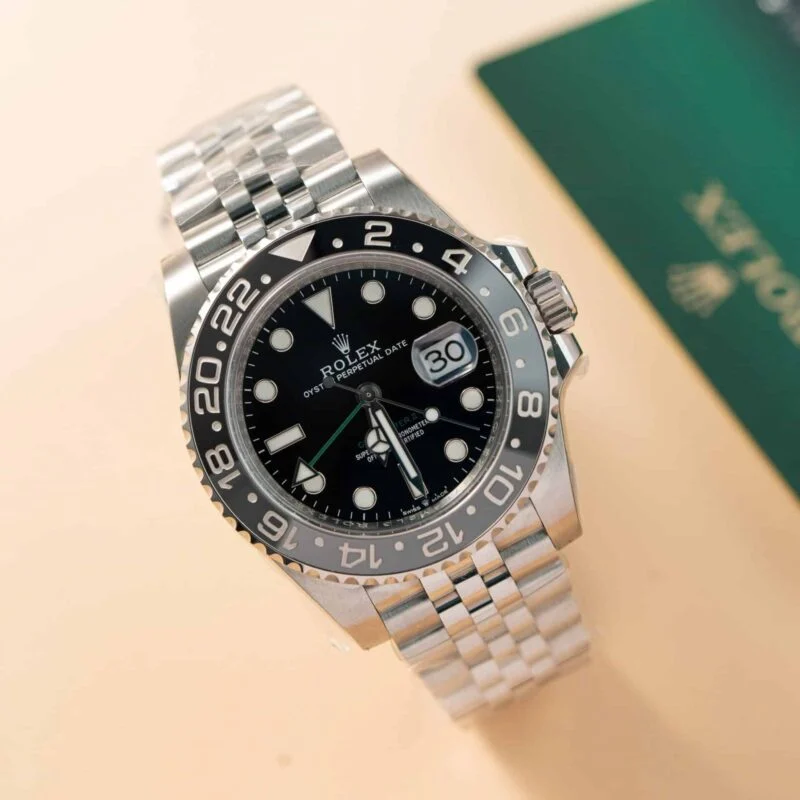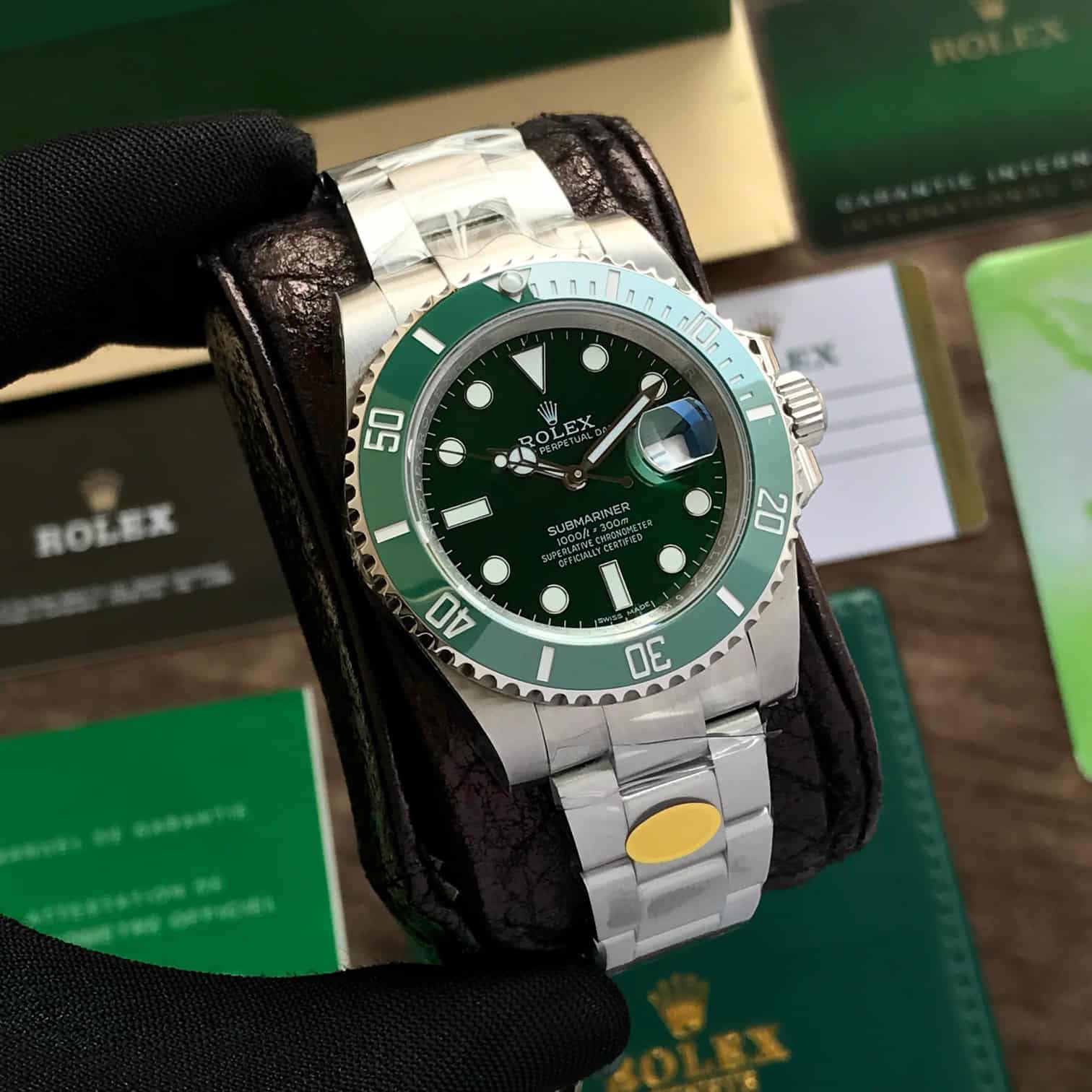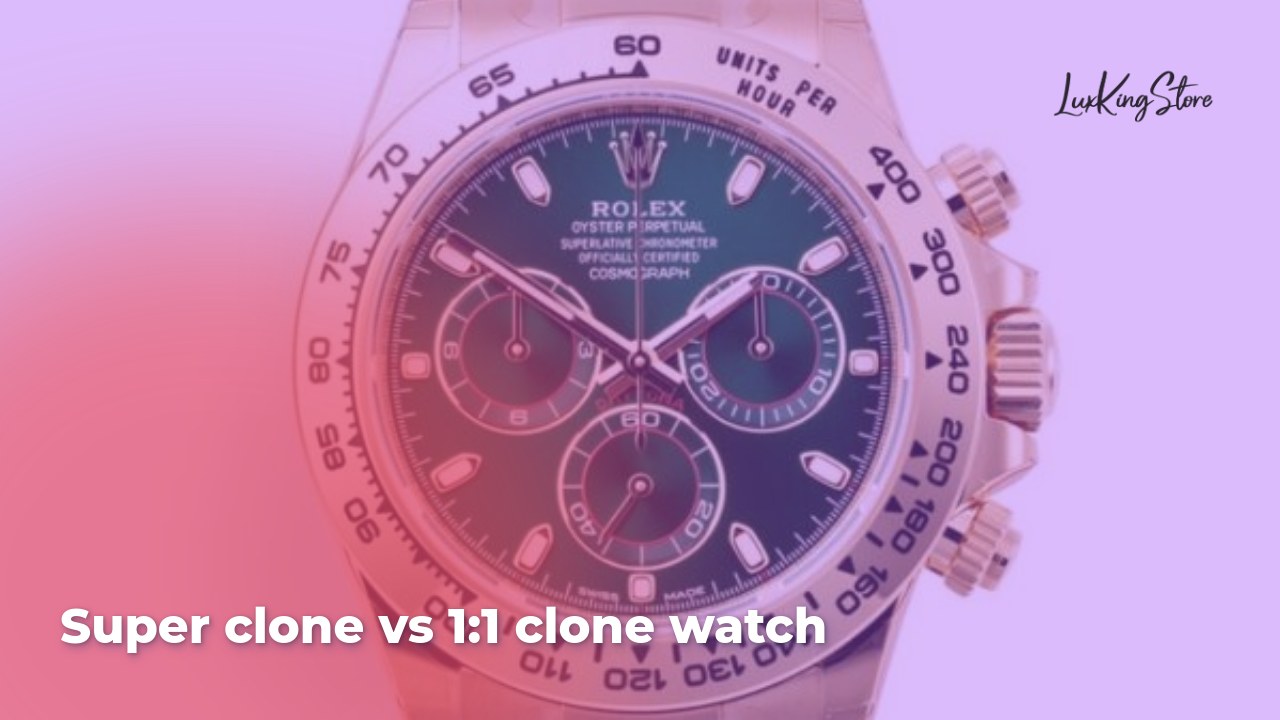Super Clone vs 1:1 Clone Watch
Super Clone vs 1:1 Clone Watch
The world of luxury watches has expanded beyond just the high-end brands like Rolex, Patek Philippe, and Audemars Piguet. Today, Super Clone vs 1:1 Clone Watch offer enthusiasts an alternative that mimics the luxurious aesthetics of these timepieces without the hefty price tag. But what’s the difference between these two categories of replicas? In this detailed exploration, we will delve into what defines super clones versus 1:1 clones, examining their craftsmanship, price, functionality, and overall appeal. Are these watches mere imitations, or do they represent a smart investment for watch lovers? Let’s unpack the intricacies of these clones, allowing you to make an informed decision in the realm of luxury timepieces.
Understanding Super Clones
Super clones are high-quality replicas engineered to resemble original luxury watches in design, functionality, and materials. They aim to achieve a level of precision that makes them nearly indistinguishable from the authentic pieces. Crafted with premium materials and precise detailing, super clone watches are often viewed as an excellent entry point for those looking to enjoy the luxury aesthetic without the exorbitant price.
Characteristics of Super Clone Watches
Super clones are notable for their attention to detail and quality. Below are key characteristics that set them apart:
- Craftsmanship: Super clones are built with meticulous attention to detail, including precise inner engravings and functionality. They commonly utilize high-grade materials, most notably 904L stainless steel, which is known for its significant corrosion resistance. This quality allows the watch to maintain its aesthetics over time.
- Movement Quality: Many super clones incorporate Swiss or Japanese movements, allowing for reliable timekeeping comparable to that of genuine luxury brands. For instance, some super clones replicate intricate features like chronographs and calendars found in original models.
- Design Accuracy: Super clones strive to mirror the original watches visually, with correct logos, dial markings, and even microfeatures like luminescent paint and textured dials. For example, a super clone of the Rolex Submariner would match its minute details, presenting a compelling argument for their quality.
Key Features
| Feature | Super Clone Watches |
|---|---|
| **Material** | 904L Stainless Steel |
| **Movement** | Swiss or Japanese movements |
| **Detailing** | Precise engravings and markers |
| **Packaging** | Mimics authentic luxury packaging |
| **Functionality** | Accurate chronographs and calendars |
In essence, these characteristics contribute to the appeal of super clones, making them an attractive alternative for collectors looking for quality and durability without compromising on aesthetics.
Common Brands Producing Super Clones
When it comes to super clone watches, a few factories and brands have developed a reputation for excellence in their craftsmanship. These brands employ advanced manufacturing techniques that ensure an impressive resemblance to the original timepieces. Here are some notable brands and factories known for producing high-quality super clones:
- Rolex – Known for models like the Submariner, Daytona, and Datejust, Rolex is one of the most replicated brands.
- Omega – The Speedmaster and Seamaster are often found in high-quality replicas.
- Audemars Piguet – The Royal Oak series is frequently cloned for its intricate design.
- Patek Philippe – Known for its complicated features, models like the Nautilus and Calatrava are popular among super clone manufacturers.
- Factories:
- VSF V6 Factory: Renowned for high-end replicas, particularly of Rolex models.
- Clean Factory: Notable for quality Omega clones.
- ZF Factory: Specializes in Audemars Piguet and Patek Philippe replicas.
This list highlights the brands most sought after in the super clone market, showcasing how deeply embedded these replicas have become in watch culture.
Price Range of Super Clone Watches
One of the most compelling reasons to consider super clones is their price point. Generally speaking, super clones fall into a more accessible price range than their genuine counterparts, making them appealing to a broader audience.
- Affordability: Super clone watches usually range from $200 to $1,500, depending on the quality and brand. This contrasts sharply with the original luxury models, which can cost tens of thousands of dollars.
Price Comparison
| Brand | Price Range (Original) | Price Range (Super Clone) |
|---|---|---|
| **Rolex Submariner** | $8,000 – $12,000 | $300 – $700 |
| **Omega Seamaster** | $5,000 – $7,000 | $200 – $500 |
| **Audemars Piguet Royal Oak** | $20,000 – $25,000 | $400 – $900 |
| **Patek Philippe Nautilus** | $30,000 – $50,000 | $600 – $1,500 |
In summary, the price range of super clone watches not only highlights their budget-friendly nature but also positions them as a viable alternative for those who appreciate luxury aesthetics without the financial strain.

Exploring 1:1 Clone Watches
Having gained insight into super clones, it’s essential to understand 1:1 clone watches. These replicas aim to provide an even closer experience to the authentic luxury watches they emulate. With the intention of achieving indistinguishment, 1:1 clones focus on replicating not only the aesthetics but also the essence of the original timepieces.
Features of 1:1 Clone Watches
1:1 clone watches aim for an unparalleled level of accuracy and quality, making them a popular choice among watch enthusiasts. Here are some of their defining features:
- Material Quality: Like super clones, 1:1 clones often use 904L stainless steel, which is a hallmark of luxury watch production. This superior material ensures that the weight and feel closely match the original.
- Craftsmanship: These watches are crafted with a detailed eye, replicating everything from the inner workings to the outer appearance. Features such as ceramic bezels and screw-down crowns are integral to achieving authenticity.
- Movement Quality: Many high-quality 1:1 clones utilize movements that closely replicate the performance of genuine Swiss counterparts. COSC-certified movements can often be found within these clones, ensuring reliability and precision.
- Aesthetic Appeal: Designed for visual accuracy, 1:1 clones boast identical dial markings and luminous materials that make them indistinguishable from luxury watches at first glance.
Key Features
| Feature | 1:1 Clone Watches |
|---|---|
| **Material** | 904L Stainless Steel |
| **Movement** | COSC-certified or equivalent movements |
| **Detailing** | Precise inner engravings |
| **Functionality** | Accurate chronographs and features |
| **Visual Appeal** | Identical aesthetics to original models |
With these features, 1:1 clone watches offer a unique blend of craftsmanship, quality, and aesthetic value, appealing to those who seek high-end styles without breaking the bank.
Popular Models of 1:1 Clone Watches
Among the vast selections of 1:1 clones, certain models have emerged as standout choices for collectors and watch enthusiasts:
- Rolex Daytona: Renowned for its iconic design and intricate chronograph features, the 1:1 clone version often replicates the original’s 4130 movement, which is sought after for its stability.
- Patek Philippe Nautilus: Known for its elegant design, 1:1 clones of the Nautilus strive to capture the tapered case shape and the distinguishing “tuna can” style.
- Omega Speedmaster: This watch not only represents space exploration but has a design that conveys timeless elegance. The 1:1 clones try to replicate every aspect, including the hesalite crystal and subdials.
- Audemars Piguet Royal Oak: If intricate designs appeal to you, then the Royal Oak 1:1 clone combines exquisite detailing and quality craftsmanship that reflects its high-end counterpart.
Price Range Comparison
| Model | Original Price | 1:1 Clone Price |
|---|---|---|
| **Rolex Daytona** | $12,000 – $15,000 | $400 – $1,000 |
| **Patek Philippe Nautilus** | $30,000 – $50,000 | $800 – $1,500 |
| **Omega Speedmaster** | $5,000 – $8,000 | $300 – $700 |
| **Audemars Piguet Royal Oak** | $20,000 – $25,000 | $600 – $1,200 |
The wide variety of popular models and their price points solidifies the appeal of 1:1 clones for those who desire a taste of genuine luxury without the astronomical costs.
Cost Comparison with Original Watches
The financial aspect of acquiring a luxury watch can lead potential owners to explore alternatives such as super clones and 1:1 clones. The disparity between the cost of original luxury watches and their clones is striking.
- Luxury Watch Prices: Genuine timepieces often come with hefty price tags, making the dream of ownership unattainable for many. For example, a basic Rolex Submariner price can soar to over $10,000, while a 1:1 clone offers a similar aesthetic for less than $1,000.
Comparative Table of Prices
| Watch Model | Original Price | 1:1 Clone Price | Super Clone Price |
|---|---|---|---|
| **Rolex Submariner** | $8,000 – $12,000 | $300 – $1,000 | $500 – $900 |
| **Patek Philippe Nautilus** | $30,000 – $50,000 | $800 – $1,500 | $1,000 – $1,800 |
| **Omega Seamaster** | $5,000 – $7,000 | $200 – $500 | $400 – $700 |
| **Audemars Piguet Royal Oak** | $20,000 – $25,000 | $600 – $1,200 | $800 – $1,500 |
This detailed cost comparison illustrates the substantial savings that can be achieved by leaning towards super clones and 1:1 clones without sacrificing style and aesthetic quality.

Comparison Between Super Clones and 1:1 Clones
Having explored both super and 1:1 clone watches, it’s fascinating to consider their parallels and distinctions. While both types represent an alternate route to luxury watch ownership, their differences in quality and precision merit discussion.
Quality Comparison: Super Clone vs 1:1 Clone Watch
When assessing the quality, the distinctions between super clones and 1:1 clones become clear. Both types of watches are crafted with superior materials and attention to detail, but varying levels of accuracy exist.
- Movement Precision: 1:1 clones often feature movements that replicate specific Swiss mechanisms, adding to their reliability and accuracy. Super clones may not always have this level of sophistication in their movements.
- Materials Quality: While both replicas utilize premium materials, 1:1 clones typically use 904L stainless steel for all model aspects. Super clones might sometimes employ alternative metals, making them slightly less authentic in feel and weight.
- Aesthetic Detailing: The craftsmanship behind 1:1 clones generally strives for an exact match to the original watch, including intricate details like engraving and finishing, while super clones often prioritize visual appeal over minute details.
| Aspect | Super Clones | 1:1 Clones |
|---|---|---|
| **Movement** | Swiss/Japanese | COSC-certified equivalents |
| **Material Quality** | 904L/316L | Primarily 904L |
| **Aesthetic Detail** | Close match, not exact | Exact replication |
| **Craftsmanship Level** | High | Very High |
In summary, the choice between super clones and 1:1 clones often depends on what the buyer values most: affordability or achieving the pinnacle of luxury watch similarity.
Accuracy in Design: Super Clone vs 1:1 Clone Watch
When it comes to the accuracy of design, 1:1 clones often hold a definitive edge. Their purpose is to provide an experience that closely resembles authentic luxury timepieces, focusing on specific design elements to accomplish this goal.
- Case Dimensions: 1:1 clones strive to maintain identical case dimensions to their originals, while super clones, albeit close, may need to find a balance between cost and precision.
- Weight and Feel: The heft of a watch can significantly impact the user’s experience. 1:1 clones often achieve similar overall weight to originals, enhancing their authenticity.
- Detail Replication: Features such as engravings and logos must be replicated with precision to create visual congruence. The attention to micro-details has become a hallmark of 1:1 clones, whereas super clones may not focus as deeply on minutiae.
| Detail Type | Super Clones | 1:1 Clones |
|---|---|---|
| **Case Dimensions** | Close, but not exact | Identical |
| **Weight** | Similar but varies | Exact or very close |
| **Micro details** | High level of replication | Exceptional, near perfection |
Ultimately, enthusiasts who turn towards 1:1 clones often desire that level of detail and authenticity in design, leading to a better overall experience.
Durability and Longevity: Super Clones vs 1:1 Clones
Durability is another essential factor to consider in the comparison of super clones and 1:1 clones. Quality craftsmanship plays a significant role in determining how these replicas perform over time.
- Component Quality: Higher-end components often contribute to more extended service intervals. Super clones typically guarantee performance for up to 5 years under expected usage conditions, while 1:1 clones often aim for prolonged longevity due to their superior manufacturing standards.
- Quality Control: 1:1 clone producers tend to implement strict quality control measures, ensuring that every watch meets high standards before it hits the market. This attentiveness can lead to improved reliability over time compared to some super clones.
- Maintenance: Both types of clones require ongoing care, but the absence of proprietary alloys, found in original luxury watches, might mean both super and 1:1 clones will have a shorter lifespan compared to authentic models.
| Durability Factor | Super Clones | 1:1 Clones |
|---|---|---|
| **Component Quality** | Good quality | Exceptional |
| **Service Interval** | Up to 5 years | Often longer due to QC |
| **Material Constraints** | Common stainless steel | High-grade 904L steel |
Overall, collectors looking for longevity and robustness in their luxury replica watches often lean more towards 1:1 clones, knowing they’ve invested in a durable alternative.
Buyer’s Guide for Super Clones and 1:1 Clones
As we transition towards making informed purchase decisions, understanding the nuances between super clones and 1:1 clones can provide invaluable insights into the watch-buying experience.
What to Look for When Buying Super Clones
- Build Quality: The heft of a watch is essential. Quality super clones will feel substantial and solid. Verify that they use durable materials, ensuring longevity.
- Movement Accuracy: Seek super clones featuring reputable movements, such as Swiss ETA clones or custom clones imitating genuine models. The functionality related to chronographs and date features is crucial.
- Attention to Detail: Investigate the finishing of the watch. Precise engravings, perfect alignment, and details like weight should mirror the original closely.
- Authentic Functions: Ensure that the watch possesses functionalities that mimic the original, such as water resistance, luminous markers, and operational features.
- Seller Reputation: Always buy from reliable sellers to guarantee authenticity and ensure a smooth transaction. Research and read reviews from fellow watch enthusiasts can provide enormous insight into a seller’s credibility.
- Value for Money: While assessing affordability is vital, remember that extremely low-priced clones might compromise quality.
By focusing on these considerations, you can navigate the world of super clones effectively, ensuring satisfaction in your purchase.
What to Consider When Purchasing 1:1 Clones
- Accuracy in Design: 1:1 clones should match the original dimensions, weight, and overall aesthetics. Pay close attention to whether they utilize the same materials as their authentic counterparts, such as 904L stainless steel.
- Internal Mechanism Quality: The movement is a crucial aspect of all watches. Ensure that high-quality clones feature automatic or mechanical movements closely replicating the original’s functionality.
- Micro Details Inspection: Pay special attention to engravings, logos, and dial printing. A reputable clone will reflect precise details that are virtually indistinguishable from authentic models.
- Brand Reputation: Research both the brand and seller thoroughly. Reliable customer feedback can inform you about their quality, accuracy, and service. Long-term performance reviews can be especially useful.
- Certification and Documentation: Ensure that the purchase includes documentation regarding the origin of the watch, including serial numbers and certification cards to boost trust and claims of authenticity.
Navigating the world of 1:1 clones involves thorough research into design accuracy, movement quality, and credible reviews, which will ensure satisfaction with your acquisition.

Customer Reviews and Feedback on Super Clones and 1:1 Clones
Monitoring customer reviews plays a critical role in understanding how well both super clones and 1:1 clones perform in real-world settings. Across forums and watch enthusiast communities, several trends emerge regarding customer satisfaction.
- Quality Assurance: Many users commend well-rated super clone manufacturers for their attention to quality features, with positive remarks specifically about material durability and movement reliability.
- Detailed Reviews: Buyers often note that 1:1 clones live up to their expectations for accuracy, leading to positive reviews based on long-term ownership experiences. Customers emphasize how identical aesthetics contribute to their satisfaction.
- Value for Money: A recurring theme in feedback for both super and 1:1 clones is their affordability compared to genuine luxury watches, allowing enthusiasts to enjoy high-end designs without financial strain.
Key Takeaways
- Purchase from reputable sellers for guaranteed quality.
- Always examine the movement and overall craftsmanship.
- Pay detailed attention to aesthetic features for authenticity.
- Value for money does not mean sacrificing quality find a balance.
Ultimately, customer reviews reflect a community of enthusiasts who value both super and 1:1 clones for their craftsmanship and affordability, contributing to the growing popularity of these alternatives.
Frequently Asked Questions (FAQs)
- Are super clones legal to purchase?
- Yes, super clones are legal to buy as they are replicas and not original counterfeit items, but be mindful of copyright and trademark laws in your jurisdiction.
- How can I identify a high-quality super clone?
- Look for reputable manufacturers, inspect materials closely, and ensure the movement is reliable, with attention to detail in craftsmanship.
- What’s the main difference between super clones and 1:1 clones?
- Super clones focus on visual replication, while 1:1 clones aim for exact dimensional and functional matches to original luxury watches.
- Are there warranty options for clones?
- Some reputable sellers may offer warranties on their replicas, but typically these won’t match the original brands.
- Can a super or 1:1 clone hold resale value?
- Clones typically don’t hold significant resale value as luxury originals do; however, high-quality clones may attract collectors if they become desirable.
Key Takeaways
- Super Clone vs 1:1 Clone Watch offer affordable alternatives to authentic luxury timepieces.
- Understanding their craftsmanship, materials, and movement quality is critical for informed purchasing.
- Researching brands and customer reviews can lead to better buying decisions, ensuring satisfaction.
- Both types of clones have unique features that cater to different preferences and budgets.
- Manufacturer reputation plays a significant role in determining the quality and longevity of the watches.
Conclusion
In a world where luxury watches signal status and craftsmanship, super clones and 1:1 clones emerge as viable alternatives that allow enthusiasts to appreciate the aesthetics and functionality of luxury timepieces without incurring exorbitant costs. By exploring the differences between these replicas, potential buyers can navigate their choices better understanding what each type can offer while remaining budget-friendly. Both options have unique qualities that cater to a diverse array of watch collectors, whether seeking a practical homage to respected brands or a meticulous replica that mimics original luxury standards. Careful research on materials, movements, and craftsmanship will ultimately lead to more satisfying purchases. As the market continues to evolve, the importance of discerning between super clones and 1:1 clones will guide prospective buyers toward choices that best meet their desires and expectations in luxury watch ownership.
Common search queries on Google:
- What is a super clone watch?
- How to choose between super clones and 1:1 clones?
- Are super clone watches worth it?
- Best brands for 1:1 clone watches?
- How much do super and 1:1 clone watches cost?

